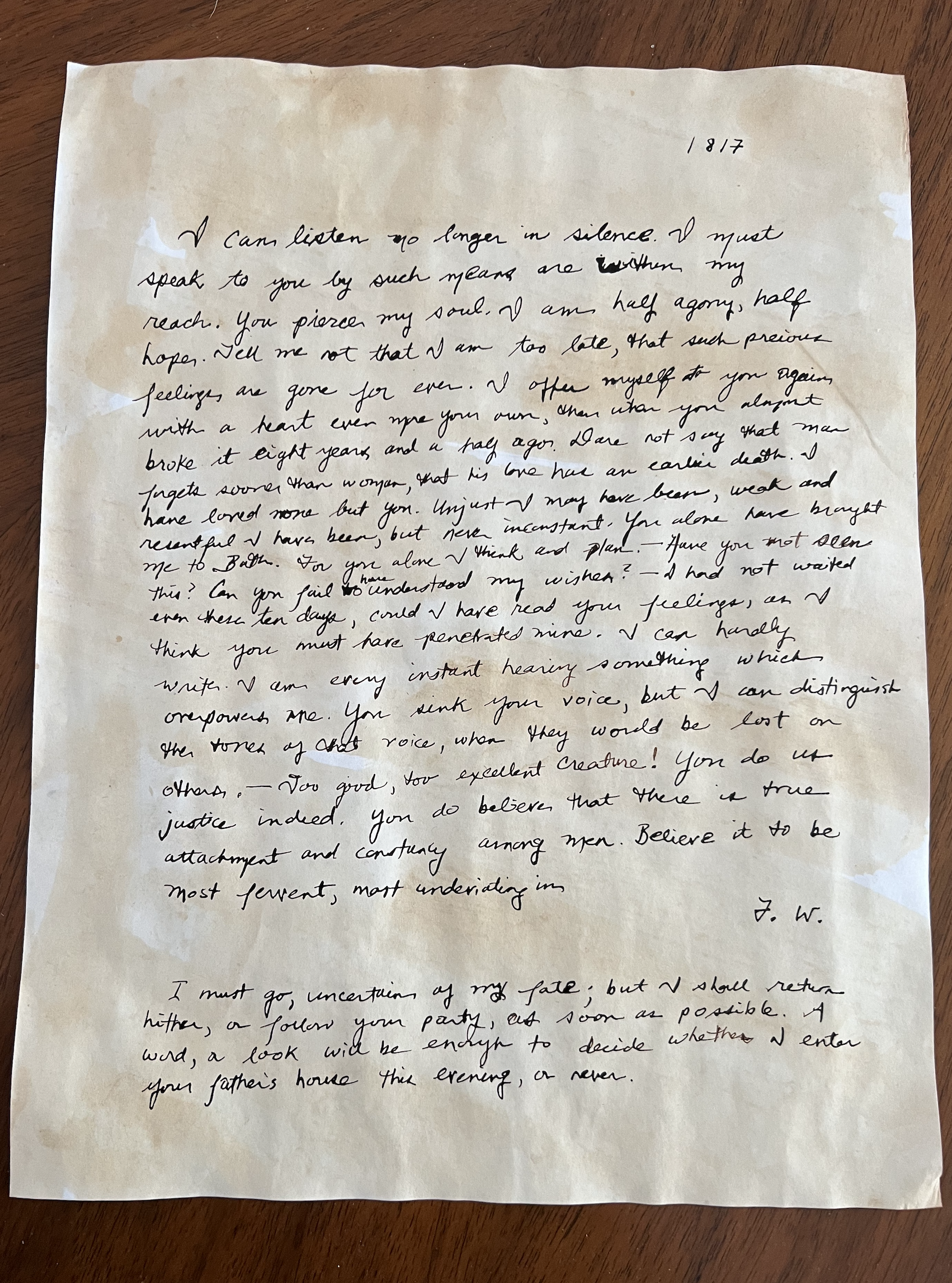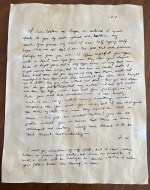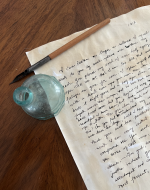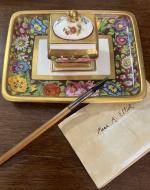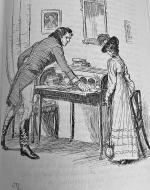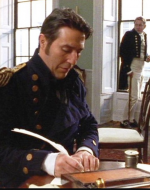Created by Catherine Golden on Fri, 09/01/2023 - 14:33
Description:
Frederick Wentworth's love letter to Anne Elliot in Persuasion (1818) remains one of the most famous love letters not only in Jane Austen's oeuvre but also in all of English literature. Copying the letter by hand deepened my understanding of Frederick Wentworth's character and Persuasion as a novel that offers a second chance at true love. This case examines Wentworth's letter--its syntax, diction, pronoun usage, and repetition--and insights from the recreation of penning a letter with attention to its style and length. The Thomson illustration gives insight into the way Wentworth delivers the folded letter to Anne with great propriety. The film still allows us to witness the circumstances prompting Wentowrth to write this famous love letter.
Recreation of Frederick Wentworth's love letter to Anne Elliot, Volume II, Chapter XXIII, Persuasion (1818) by Jane Austen, crafted by Catherine J. Golden, 2023. Wentworth's directness and passion became palpable as I copied this letter that makes tangible his longlasting love for Anne. Wentworth writes to Anne: "You pierce my soul. I am half agony, half hope. Tell me not that I am too late." Wentworth conveys his experiences of despair and expectation. While he uses the command form in urging Anne to admit she still loves him, Wentworth also makes himself vulnerable in placing him as the object of her "piercing" love--it is Anne Eliot who "broke" his heart eight and a half years ago and who still has the power to penetrate his soul. Striking too is how in touch Wentworth is with his emotions. He freely uses "I" often to express his love for Anne, but he also uses "you" to convey both the power Anne's love still holds over him and his attentiveness to her needs and wants: "You alone have brought me to Bath. For you alone, I think and plan. Have you not seen this? Can you fail to have understood my wishes?" As these and other lines reveal, Wentworth's well-written and thoughtful letter has sophisticated and emotion-laden diction, effective pronoun usage, and powerful use of repetition. It is also a brave letter, especially in the epitaph where Wentworth places his fate in the hands of one who refused him despite her love for him.
Composing Frederick Wentworth's Letter with Nineteenth-Century Pen and Inkwell, from the Collection of Catherine J. Golden, 2023. This image pairs a Regency style pen and inkwell with a letter written on antique-style paper. I created the paper by using a British brand of black tea, PG tips, to stain white printer paper to look authentic to the Regency era. The dip pen allowed me more control over my writing than a quill, which Wentworth likely would have used to write his letter. The inkwell is a plain one, but it has meaning to me--I found it while gardening in the backyard of my Victorian home, built in 1869. Penning the letter, I became very aware of its length--my hand began to cramp--and of Wentworth's fluency with long and short sentences to great effect. The character has an impressive syntactic repertoire and speaks with passion.
Folded Letter with Regency Pen and Spode Deskset, from the Collection of Catherine J. Golden, 2023. Spode is a high quality China that dates to 1770 and still remains popular today. This deskset with inkwell set on a four-sided pen tray has gold borders on the inkwell and tray. A gentleman of Wentworth's standing at this point in the novel could easily afford a deskset of this quality. In addition, this image shows Wentworth's folded letter addressed on the outside to "Miss A. E---," Elliott! In the Regency era, letters were folded rather than placed in an envelope. There are several ways to fold a letter: this letter folds the sheet into three, then rotates the letter 90 degrees, and folds the letter into thirds again, tucking the bottom flap into the top flap. The front of a Regency letter includes only the name and/or address of the receiver (the sender's name appeared only inside the letter). On the back is applied sealing wax and a stamp to fasten the letter. Folding a letter was common. Folded letters with a wax seal may look quaint, but this method was a pre-1840s cost cutting measure since that same missive, posted in an envelope, would receive double charge.
Hugh Thomson, "Placed it Before Anne," 1897, for Persuasion (1818), Volume II, Chapter XXIII. Jane Austen's novels were published in volume form without illustrations, but in the 1890s they appeared as gift book editions with color illustrations by Charles and Henry Brock and pen-and-ink illustrations by Hugh Thomson. The artist spent weeks in the British Museum and the Victoria and Albert Museum, looking at Regency fashion and furniture to guide his illustrations. Such details of furniture and fashion resonate in "Placed it Before Anne." Here we find a rolltop desk, portraits, and an ornate mirror on the walls. The artist renders their clothing in great deail from the smart cut of Wentworth's tailcoat, snug breeches, and Hessian boots (appropriate for wearing in the day) to Anne's visiting gown, lace fichu (or tucker, for modesty), feathered hat, and reticule. With just a few lines, Thomson captures the personalities of Austen's characters as well as their settings, arguably adding to Austen's fiction. This illustration responds to the lines in Volume II, Chapter XXII that read: "Wentworth] drew out a letter from under the scattered paper, placed it before Anne with eyes of glowing entreaty fixed on her for a time, and hastily collecting his gloves, was again out of the room, almost before Mrs Musgrove was aware of his being in it: the work of an instant!" Thomson shows us Wentworth's look of hopefulness as he discretely pulls out the folded letter addressed to her all the while "fixing" his gaze on the woman he still loves. Wentworth knows that a man cannot correspond with a woman unless he is engaged to her, so he uses the ruse of forgetting his gloves as excuse to reenter the room and makes great haste in drawing out the letter to protect Anne's reputation--Anne modestly does not make eye contact with him but rather looks down at the much anticipated letter.
Film Still of Frederick Wentworth, played by Ciaron Hinds, Penning a Letter to Anne Elliot, Persuasion 1995 version, directed by Roger Michell. Here we see Wentworth in the process of writing his letter using a quill pen and ink. An opening writing desk with inkwell lies atop a table in front of him; a canister of pounce--a powdery substance used to blot ink--sits at his side. Wentwirth played by Ciaron Hinds seems totally engrossed in writing his letter. However, director Michell makes this scene a pregnant moment since we simultaneously see Anne and Captain Harville conversing in the background on the topic of who loves the longest, man or woman. It is this conversation that prompts Wentworth to write the letter that reaffirms his love for and commitment to Anne Elliot after eight and a half years of separation. Austen moves us quickly from the writing of the letter to the receiving of the letter, telling us Anne's reaction: "Such a letter was not to be soon recovered from. Half an hour’s solitude and reflection might have tranquillized her; but the ten minutes only which now passed before she was interrupted, with all the restraints of her situation, could do nothing towards tranquillity. Every moment rather brought fresh agitation. It was overpowering happiness." Next Anne and Wentworth find their way to the Gravel Walk in Bath where they come to an understanding of their love, but I chose this image for here we focus on the creation of the perfect love letter.

